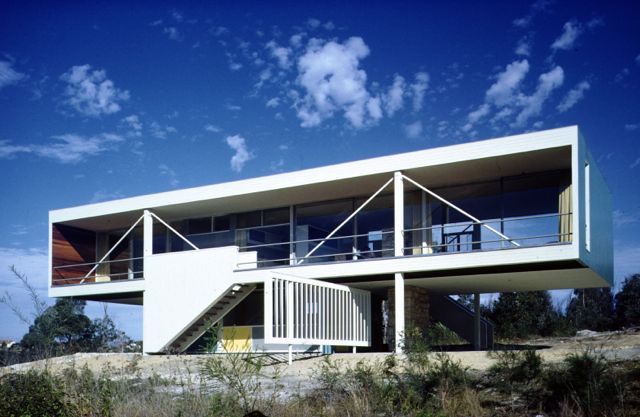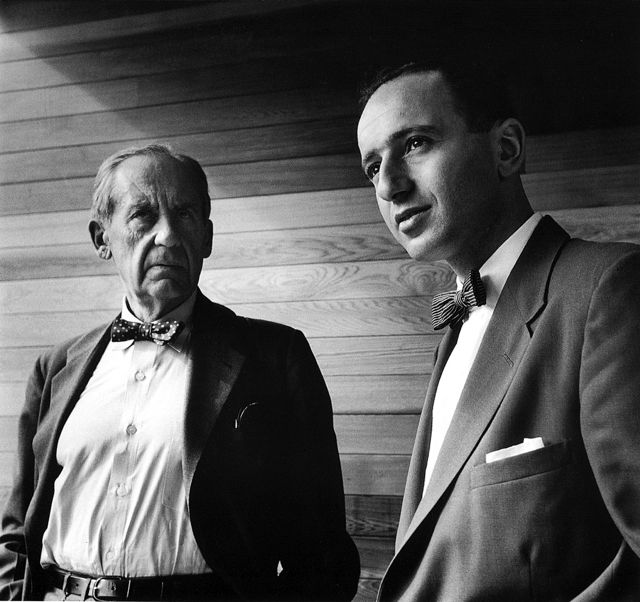Photo: Walter Gropius (L) and Harry Seidler (R). Gropius was the founder of the Bauhaus and a huge influence on Seidler.
It’s rare that an exhibition celebrating the life’s work of a single artist, or in this case architect, is done vicariously through others. Harry Seidler: Architecture, Art and Collaborative Design, opening tonight from 5:30 to 7:30 p.m. at the Black Mountain College Museum and Arts Center, is just that: An intimate look at some of the pivotal moments in Seidler’s upbringing and the relationships forged with those around him.
Vladimir Belogolovsky, the exhibition’s curator, has amassed a collection of photographs, notes, books, models, films, newspaper clippings, drawings, sketches and correspondences that develop a long-term image of Seidler’s work through collaborations. The show is a living, breathing document that jumps from person to person, rather than year to year.
Many an exhibition includes such material — a letter here, and picture and postcard there — stuck between paintings in an effort to “liven up” the show and add some bit of personal character to the artist and the work. But not here. The photographs assist the documents. Belogolovsky’s organized the imagery to, in effect, serve the reservoir of primary sources. Though, that’s not to say there’s a ton of reading, as many of the items draw visual comparisons between Seidler and other artists and architects.
Each of the nearly dozen display cases and corresponding large-scale architectural photographs create a web of stylistic influence between Seidler and other artists and architects. Bauhaus founder Walter Gropius, Marcel Breuer, Pier Luigi Nervi, Max Dupain, Josef Albers, Alexander Calder and Frank Stella are among those featured in the exhibition.
Seidler’s career was one spent refining his architectural philosophy. “He wasn’t interested in the architectural revolution,” Belogolovsky told Xpress. “He was about reworking architecture.” With each artist and architect he encountered, studied or worked with, his own form changed. Belogolovsky has lent a hand in tracing these style-shifting relationships, the details of which are spelled out in the letters and comparative drawings, diagrams and photos.

Photo: The Julian Rose House, Design/Completion 1949-1950, Wahroonga, Sydney, Australia. Steel structure, timber infill.
The exhibition’s wholeness gives the idea that Belogolovsky’s own life and career as an architect and writer has long-incorporated the study of Seidler’s work. But it hasn’t. Belogolovsky was first exposed to Seidler in 2010 while giving a lecture on Spanish architecture in Sydney, Australia. It was there that he met Penelope Seidler, Harry’s widow and struck up the idea to create a traveling exhibition. The exhibition has already toured in eastern Europe and Houston. It’ll travel to Winnipeg and Charlottesville after leaving Asheville in August.
“I was struck by the quality, and why I had never heard of him. And I was struck by the quantity of his work in Sydney,” Belogolovksy said. “There are so many skyscrapers and buildings that you could call it Seidler City.”
Seidler was Austrian by birth, but Australian by legacy. And it’s likely that you haven’t heard much of him. That is, unless you’ve studied mid-century modernist architecture and the legacy of the Bauhaus-turned-Harvard/Yale faculty. He’s also among the multitude of artists and architects that made the pilgrimage to Black Mountain College to study with Josef Albers. Albers, like Seidler and Bauhaus founder Walter Gropius, had fled the central Europe in the 1930s. Seidler’s route was less direct than those of his colleagues.
The exhibition traces his movements from central Europe to England, then Canada, Boston, New York and eventually to Australia. It was in Australia that he built a career through the cross-continental collaborations that Belogolovsky credits with his success.
His family sought refuge in England after fleeing Nazi-controlled Austria. In 1940 he was forcibly sent to Canada, where, at age 18, he and other “enemy aliens” were held in a British internment camp. It was there, through personal study, that he was introduced to modernist architecture, the Bauhaus movement and its key players, whom he would eventually work with.
In October 1941 Seidler was allowed to leave the internment camp to study at the University of Manitoba. After graduating, he went to Harvard where to study under and work with Gropius and Marcel Breuer. It was Gropius who would direct him to Black Mountain College where he studied color and design under Albers in 1946. He returned to New York to work at Breuer’s architectural firm before permanently relocating to Australia.
He initially visited Australia in 1948 to build a home for his family, who had relocated in the mid 1940s. Seidler used plans for a house that he and Breuer drew up in 1947. The house was imagined for a Massachusetts location, but realized on land outside of Sydney. It’s design and materials were uncommon in Australia. The layout also had to be adjusted to accommodate the land, which they hand-picked to better suite the house. Even the furniture was imported from New York, Belogolovsky said. Architecturally speaking, it was poorly planned — a near disaster.
“For most architects the first work is like a manifesto,” Belogolovsky says, “and he almost killed his reputation with his first work.” But the work became a huge success in Australia. Commissions and design requests mounted as more and more people traveled to see the house. With this work, Seidler is credited with bringing modernist architecture to Australia.
“Harry Seidler: Architecture, Art & Collaborative Design” opens tonight from 5:30 to 7:30 p.m. at the Black Mountain College Museum and Arts Center at 56 Broadway. The show runs through August 21. This event is free to members and students and $3 to the general public. For more info about the exhibition, go here.




Before you comment
The comments section is here to provide a platform for civil dialogue on the issues we face together as a local community. Xpress is committed to offering this platform for all voices, but when the tone of the discussion gets nasty or strays off topic, we believe many people choose not to participate. Xpress editors are determined to moderate comments to ensure a constructive interchange is maintained. All comments judged not to be in keeping with the spirit of civil discourse will be removed and repeat violators will be banned. See here for our terms of service. Thank you for being part of this effort to promote respectful discussion.